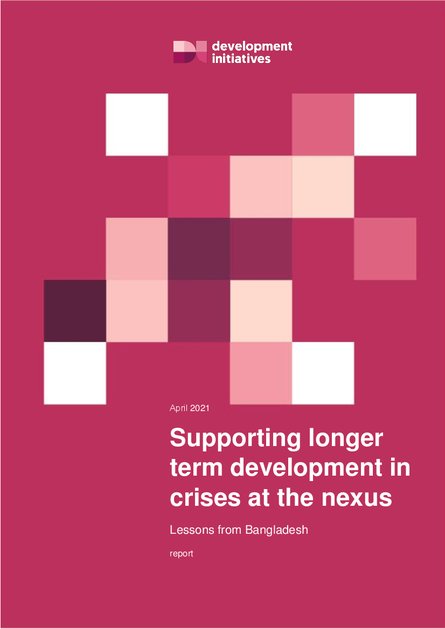
This country report on Bangladesh contributes to a multi-country study focusing on the role of development actors1 in addressing people’s long-term needs in crisis contexts and supporting operationalisation of the humanitarian−development−peace (HDP) nexus. This is also pertinent to the Covid-19 response, involving both immediate lifesaving assistance and longer term support for health systems. 2 This study is part of Development Initiatives’ programme of work on the nexus and aligns with objectives of the Inter-Agency Standing Committee (IASC) Results Group 5 on Humanitarian Financing. It builds on 2019 research on donor approaches to the nexus3 and the IASC’s research on financing the nexus, 4 which identified a gap in understanding how development actors address longer term development needs of vulnerable people and structural causes of crises.
This research will build the evidence base for how development actors work in crisis contexts, informing national and global development policy and decision-making. Development Initiatives, with support from the Food and Agriculture Organization of the United Nations (FAO) and the Norwegian Refugee Council under the umbrella of IASC Results Group 5, will engage with development actors on its findings.
Using the example of Bangladesh, this report aims to improve understanding of how development assistance currently targets crisis-affected people and addresses the structural causes of crisis. It explores how development actors support the delivery of joined-up responses in Bangladesh by working alongside and in collaboration with humanitarian actors at the strategic, practical and institutional levels. It identifies examples of good practice, learnings and recommendations for how development assistance can better prevent and respond to crisis situations and support the delivery of the HDP nexus agenda, both within Bangladesh and potentially elsewhere. One of the limitations of this research in covering a range of issues and actors is the trade-off with the degree of depth we were able to look into specific areas. It is therefore not intended to be a comprehensive or exhaustive review, and various observations that would benefit from further research are highlighted in the report.
